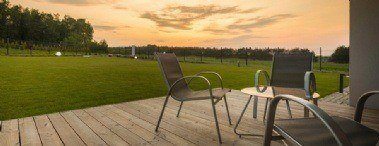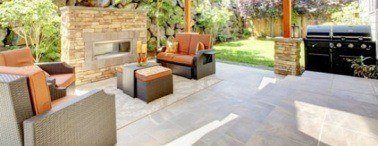
Building a deck is one of the easiest and the most inexpensive ways to add living space outside your home. Because unlike a patio, a deck usually has a wood frame and can be placed at ground level, flush with your second-story bedroom or as high as the roof-line of your home. It can be a small, useful space for your enjoyment or a massive testament to style and recreation. And an already-existing deck can be enlarged, resurfaced or re-colored with a weekend's contribution of time because it's just wood.
A deck is also one of the very few builds or renovations that can be accomplished within a tight budget. If the ground is not a slid rock, sand or marsh, a contractor can usually quote a definite price because the material prices and labor costs are fairly stable. In other words, if the estimate for building the deck is $3600, you can pretty well be sure that the final cost will be the same. This is because there are very few variables to move the price around.
Here are some considerations and ideas that should be at the back of your mind when you're going to build or renovate your deck, so that you can get the most from you investment.
Cost Estimate
The amount of money you can afford directly affects the size and scope of your deck. If there is a lot of preparation work to be done, like removal of old deck or groundwork, the price is likely to go up. But if it is just a regular square deck built within 4' of the ground, you can calculate its approximate cost by the following rule-of-thumb:
Take the cost of materials and double it. So if you go down to the store and price out the materials for deck and they come to $1200 then, with labor and other considerations, the deck will most likely come out to around $2400. This is also a good number to keep in your head when contractors give you estimates.
Shape, Size and Levels
The shape of your deck will be dictated by your budget and will decide its utility and looks. For example, the cost a rectangular deck will be lower than the cost of a diamond-shaped deck, because the latter will require extra cutting and shaping. A good carpenter will take more time to make sure that the shape and angles are accurate, and may charge a higher price. Apart from the shape and size, you should also consider the levels.
Many decks are built for high utility, with two or three levels for grilling, cooking, or even spa facilities. Fireplaces with large chimneys are finding their way out to the decks allowing a great deck life even when the weather gets cold. Homeowners are adding posh, waterproof furniture and TV screens just like in the den. If you live in an area that is very hot in the summer, a misting system, fine water drops propelled by a fan, can take the heat away.
Railings and Posts
Decks have railings mainly for safety. But just like window trim and shrubs set off the front of the home, railings and posts define what is otherwise a flat, boring platform. Railings are the functional supports and the balusters, although providing protection, are structural decorations. In older-style homes the posts are a 4" X 4" carved, Victorian style columns with matching carved balusters, whereas a modern deck may have tempered-glass panels between the posts. The former is more for decoration but the glass, although modernistic, is protection from the wind.
One of the breakthroughs in railing design is the type of materials. Rather than the high-maintenance that wood railings require, these long guard-rails are now being made from powder-coated aluminum, composites and vinyl. In addition, these railings can come in 4' and 8' assembled panels that can easily be attached to posts bolted into the decking. These are more expensive but you can recoup most of the price from the labor savings over the installation of wooden posts and balusters. And then there is the saving in time and money you would have had to invest in painting.
Below Decks
One of the newest movements in deck building is to provide a usable space underneath the deck. This means instead of a dead space where water trickles down between the decking boards the area is used for storage. Of course, to make this area functional the surface of the deck would have be at least 6 feet high, or 4 feet if you don't mind bending over.
The decking is covered with a waterproofing to divert the water into a small gutter system and away from the home. In many cases the deckwood can be used as a platform for fiberglass sheeting which is then saturated with the epoxy to make it a hard surface. Then this surface is painted with non-stick paint or covered with an outdoor carpet. For a more realistic deck waterproofing is stretched over the joists and then vinyl or composite decking is placed down over that with a sealing solution on the bottom sides.
So, are you closer to your vision of the ideal deck for your home after reading this article? Don't forget to browse our extensive photogallery to see how other homeowners are building their decks.
Posted by: TrustedPros





